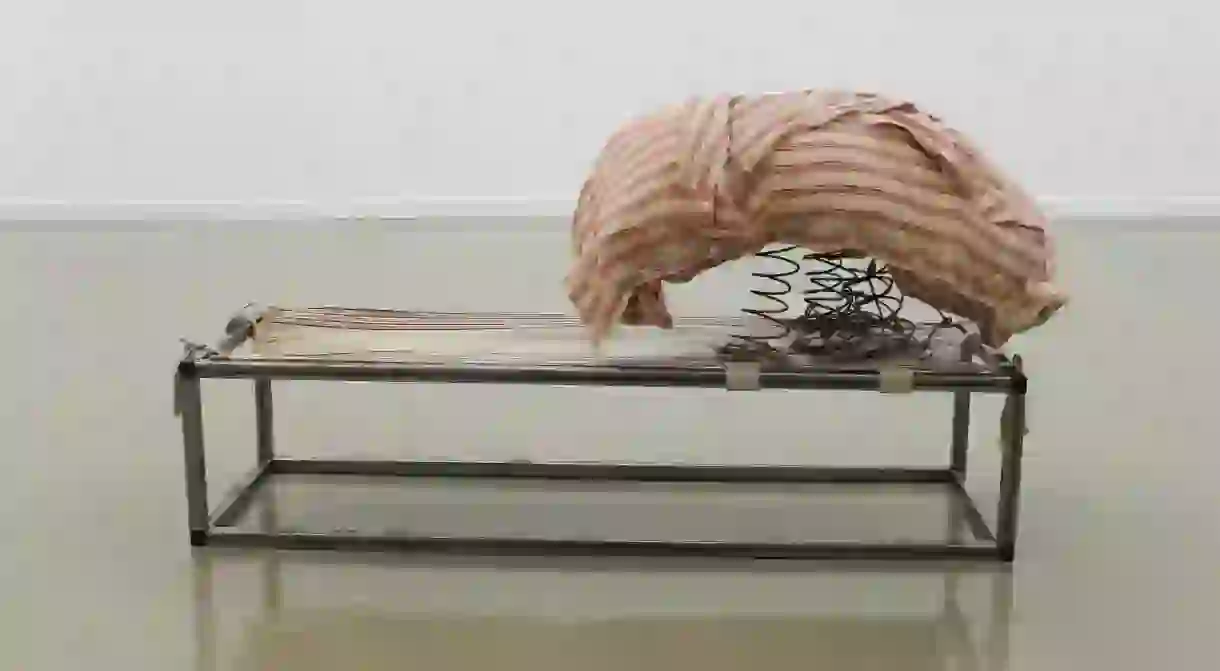How This Norwegian Artist Uses Clothes to Talk About Mental Health

According to artist Kari Anne Helleberg Bahri, clothes are linked to people: to our identities, the things that have shaped us, the things that bind us—and those keep us from falling apart. Kari Anne, who studied clothes and costume design, “infuses” clothes into her art, creating clothes-like objects that are a study of today’s society and a critical (but not unloving) glance at various mental health issues.
I dress / Therefore I am? The title of the joint exhibition at the Akershus Kunstsenter, where Kari Anne Helleberg Bahri and four other artists, all working with textiles, presented their latest works, is a reference to Descartes’ “I think, therefore I am.” According to Kari Anne, when it comes to clothes, the idea was whether we can trust what we see: could it be that what we see in the distance looks like something else up-close?
With her project …until today, Kari Anne wanted to visualize the components that have formed and shaped us to be who we are today. “As humans, we experience incidents that mark us, shape our way of thinking and make us who we are. The objects in this project describe thoughts and feelings we may experience. Thoughts around identity, existence, finding your place, insecurity, pressure, chaos… but also optimism, humor and courage. It’s based on my own life: my ‘clothes-like’ objects show fractions of my history until today.”

The exhibition is part of a program called Kunstvisitten. In addition to Akershus Kunstsenter, it will visit 16 institutions in 2018, mainly day centres for people with mental issues, in the Akershus county. The artists will visit each institution and talk with the patients about their artwork.
“I have visited a few institutions in Akershus and it has been very exciting,” says Kari Anne. “I have found that the best thing to do is try to find some answers together. We, the participant patients and I, have started to analyze the title of the exhibition, I dress / Therefore I am?. We have talked about what different clothes symbolize or communicate—like social classes, professions and personal interests—and questioned whether we can trust our stereotypical references. Together, we have tried to figure out what my objects mean to them; what they look like, what it reminds them of and so on. It’s like a riddle to solve. It is really interesting that we often see the same things, them and I. When I tell them a bit about my thoughts around the objects, I am being quite personal: my work is personal and it’s important for me to show that I am, like most people, trying to figure it out. Figure life out.”

During her visits, Kerri Anne will ask each group what they think art and its purpose is. “Does it have to look pretty or can it be ugly? If they paint or draw something that doesn’t look nice, are they likely to throw it away or should one be allowed to exhibit an ugly picture? My hope is that the patients can see art as a language and that they can use it to express their feelings. It doesn’t have to look good.”
If someone were to depict mental health as an item of clothing, what would that be like? “It might be some sort of armor. A soft armor, whose purpose is to protect the wearer, give them support and stop attacks from the outside. The armor should not be heavy or made of metal; it should be flexible and easy to move in. It could be made out of parts of old clothes that your family has worn—the people who participated in raising you and preparing you for life, who are meant to support you. Maybe I would focus on the stabilizers inside old clothes. Opening up an old suit reveals fantastic work and fabric used for stabilizing the garment. Using that would accentuate the element of support and stability in the object further.”

In the future, the artist would like to combine textiles with metal constructions. “I would like to learn welding, so that I can create frameworks for my textile-objects. It will also work as a visual element that will give my objects more ‘power.’ I want to communicate something fundamental, powerful and hardcore: surviving. Textiles together with solid, rusty metal like iron will push the visual expression in the direction I am trying to achieve.”













